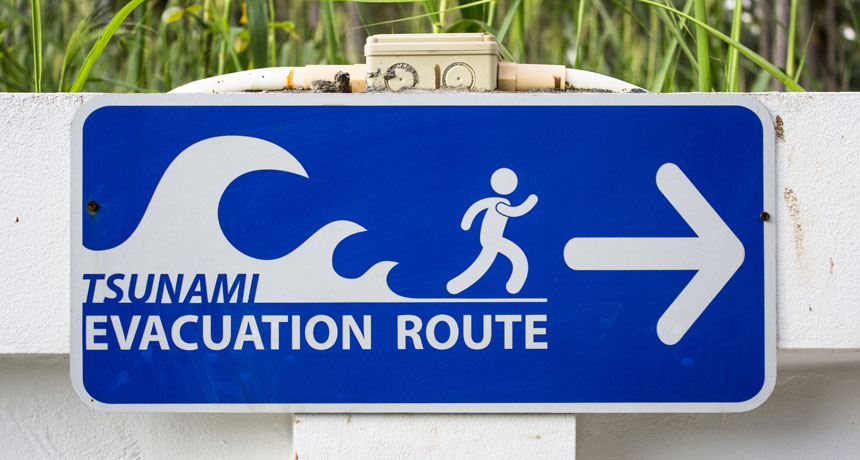Explainer: What is a tsunami?
These waves move enormous amounts of water with devastating — and deadly — power

In many coastal areas, signs show people how to get away from the danger zone when a tsunami is on the way.
coramueller/istockphoto
Splash in the bathtub and waves slosh. Toss a rock into a pond and ripples move outward in expanding rings. In each case, the water moves in waves. Those waves carry energy. And the more energy that gets added to a watery environment, the more powerful the waves may become.
Now imagine an undersea earthquake or landslide and the tremendous amount of energy it can transfer. This movement of Earth’s crust can shift huge volumes of water, unleashing a parade of great and powerful waves. This water races away at speeds up to 800 kilometers (500 miles) per hour, or as fast as a jet plane.
Eventually those waves reach shallow water. Here, they slow down and swell, sometimes as high as a 10- or 20-story building. When the waves eventually crash onto land, they can swamp hundreds of kilometers of shoreline. They may snap trees like twigs, collapse office buildings and sweep away cars. Among nature’s most powerful forces of destruction, these waves are called tsunamis (tzu-NAAM-eez). The Japanese term means “harbor wave.”
Tsunamis strike coastal regions about 10 times every year. In coastal regions, tsunamis are often the main cause of deaths associated with earthquakes. Some tsunamis have been particularly devastating. A 2011 earthquake off the coast of northern Japan, for example, sparked a tsunami that reached as high as 40.5 meters (133 feet). It destroyed entire towns. And a 2004 earthquake in Indonesia sent tsunami waves throughout the Pacific, Indian and Atlantic Oceans. That tsunami killed some 230,000 people in 14 countries.
There’s no stopping a tsunami. There are, however, ways to limit its impacts. Getting people out of the way is the most important.
There may be warning signs that a tsunami is on the way. The earth may shake. Sea level may quickly drop. That sometimes happens before the wall of tsunami water arrives. There may even be an unusual roaring sound. Beachgoers who notice these signs should immediately move to higher ground.
But those warning signs don’t always occur. And they may not leave people enough time to escape. So scientists like oceanographer Dailin Wang, who watches for tsunamis at the Pacific Tsunami Warning Center in Hawaii, are developing fast and accurate tsunami forecasts. These researchers keep an eye on the Earth using a worldwide network of buoys, seismometers and satellites. When necessary, these experts warn shoreline populations that potentially devastating waves are on the way.
And one day, it might be possible to use cloaking technologies to lessen a tsunami’s destruction. Technologies to do this are already under development, although no one is certain how well they will work.
Power Words
(for more about Power Words, click here)
buoy A floating device anchored to the bottom of a body of water. A buoy may mark channels, warn of dangers or carry instruments to measure the environment.
earthquake A sudden and sometimes violent shaking of the ground, sometimes causing great destruction, as a result of movements within Earth’s crust or of volcanic action.
seismic wave A wave in the ground produced by an earthquake or other means.
seismometer An instrument that detects and measures tremors (known as seismic waves) as they pass through Earth. The graphical output of the waves it detects is known as a seismograph.
tsunami One or many long, high sea waves caused by an earthquake, submarine landslide or other disturbance.







